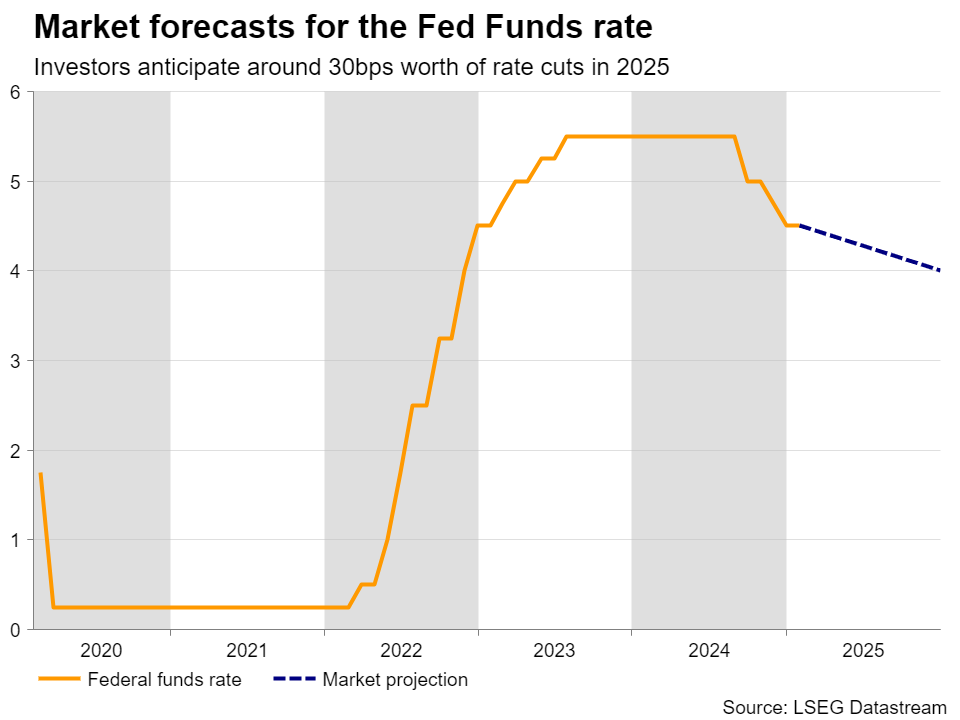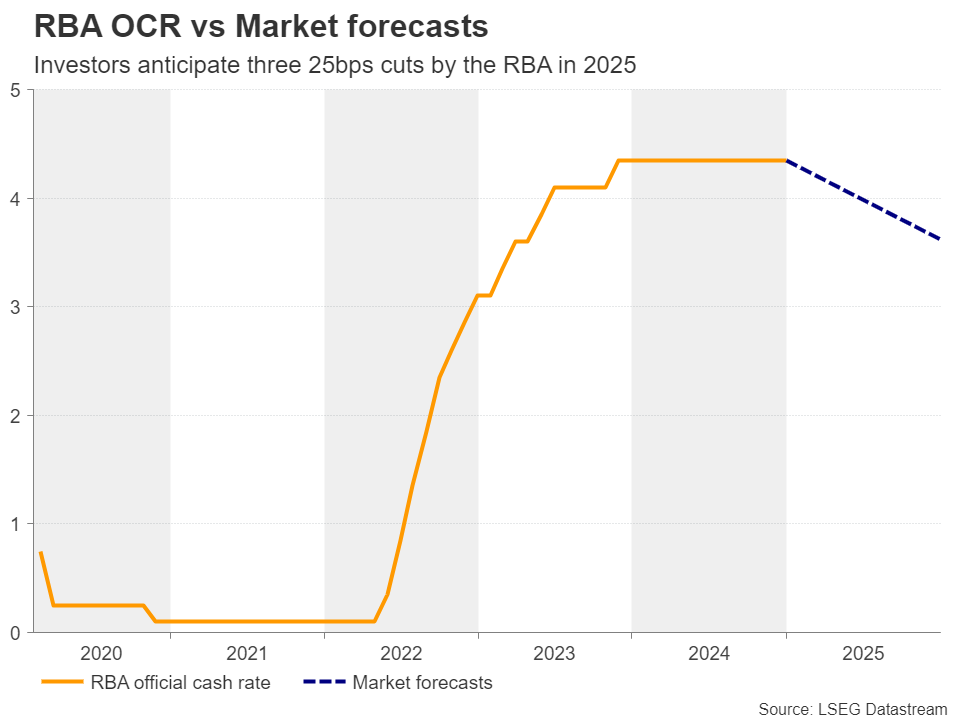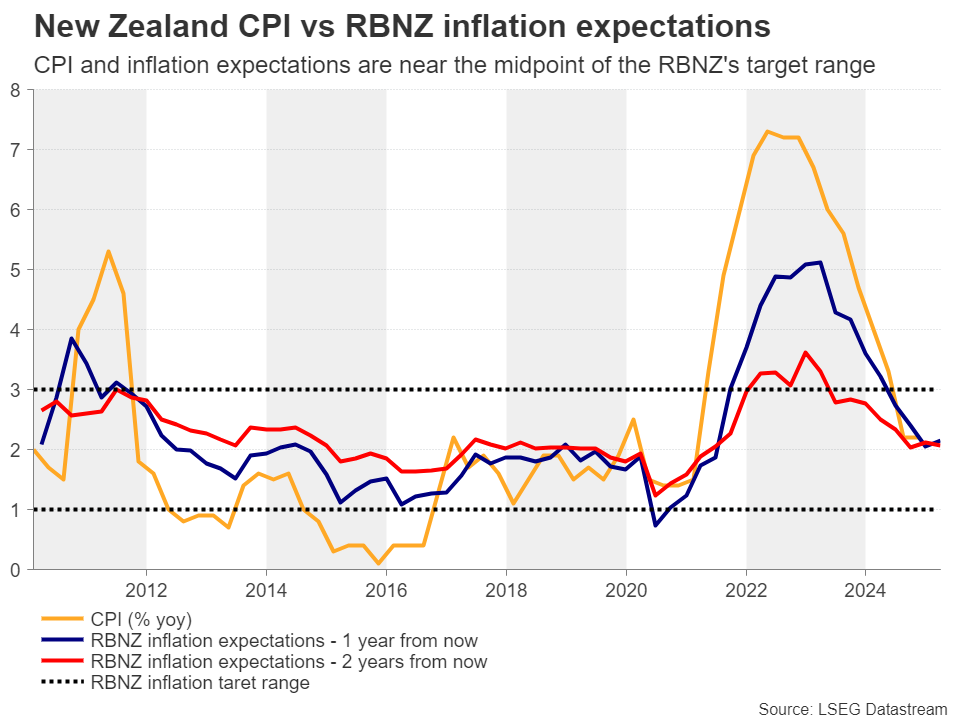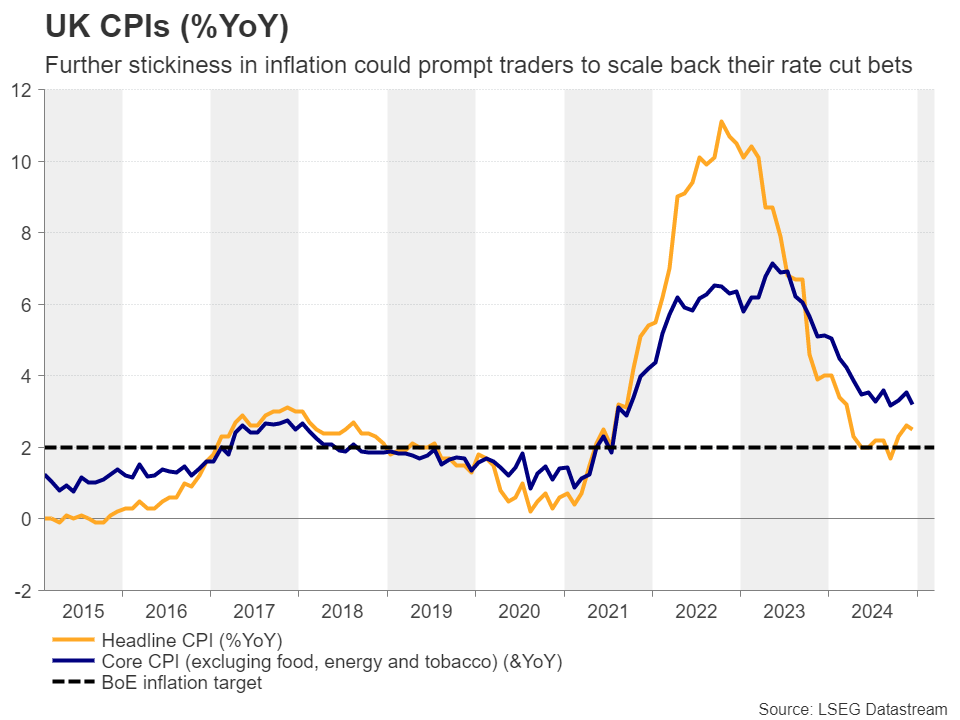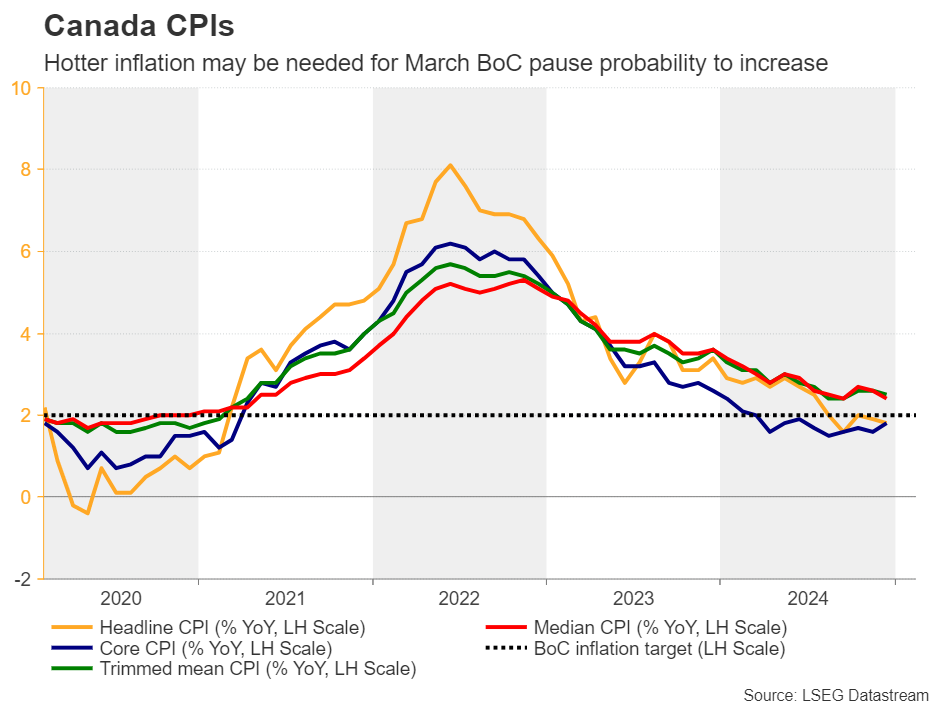-
After Powell and CPI data, dollar traders turn to Fed minutes.
-
RBA to cut rates by 25bps, focus on forward guidance.
-
RBNZ may opt for a third consecutive 50bps rate cut.
-
UK, Canadian and Japan’s CPI data also in focus.
Will the minutes confirm hawkish Fed bets?
The US dollar started the week on a strong footing after Trump announced 25% tariffs on steel and aluminum imported to the US and signaled his intention for “reciprocal tariffs” on every nation that imposes duties on the US. Then, while testifying before Congress, Fed Chair Powell reiterated the message that the Fed is no rush to further lower interest rates, while on Wednesday, the US CPI data revealed that inflation was stickier-than-expected in January, allowing for some further strength.
Even though the greenback pulled back on Thursday and Friday, all these developments came on top of a strong NFP report for January and thus prompted investors to price in only 30bps worth of rate reductions this year, a more hawkish view than the Fed’s own projection of 50bps cuts. In other words, traders are fully pricing in only one quarter-point cut by December.
With that in mind, investors may pay extra attention to the minutes of the latest FOMC decision, due out on Wednesday. Although the aforementioned events occurred after the meeting, traders may be eager to scan the report for clues and hints on how willing policymakers were to reconsider their policy path should upside risks to inflation increase. A hawkish flavor could benefit the US dollar and send Treasury yields higher, while hurting equities due to concerns about higher borrowing costs for longer.
A set of robust flash S&P PMIs for February on Friday could add more credence to that view.
RBA to begin its easing cycle
On Tuesday, the RBA will announce its first monetary policy decision for 2025. At its last meeting for 2024, the Reserve Bank of Australia decided to leave its cash rate target unchanged at 4.35%, noting that longer-term inflation expectations have been consistent with the inflation target and that the Board is gaining confidence that inflation is moving sustainably towards their objective.
And all this was even before Trump’s inauguration and the imposition of tariffs on China, Australia’s main trading partner, as well as duties on steel and aluminum coming to the US from any nation. Steel is made by mixing carbon and iron, and iron ore is Australia’s top export. Aluminum is also one of Australia’s top 20 exporting materials.
Combined with the further slowdown in the CPI data for Q4, concerns about how tariffs could impact the Australian economy prompted investors to factor in nearly three quarter-point cuts for this year, with the first one largely expected at this gathering. Specifically, traders are assigning an 80% chance of a reduction now, and thus, a rate cut on its own is unlikely to shake the aussie much.
This will be the Bank’s first reduction in this cycle and thus, investors may be eager to find out how policymakers are planning to move thereafter. Anything suggesting that the RBA may embark on an easing cycle more aggressively than investors are currently expecting could weigh on the aussie, while the opposite may be true if officials maintain data dependency, without providing clear signals about their way forward.
RBNZ: To cut by 50 or 25bps?
On Wednesday, the central bank torch will be passed to the RBNZ. In contrast to the RBA, the RBNZ has already cut interest rates three times, with the latest two decisions being 50bps worth of reductions.
The prior meeting was held on November 27 and since then, GDP data revealed that New Zealand fell into deep recession in Q3, contracting 1% qoq after shrinking 1.1% in Q2. On top of that, the year-on-year CPI rate for Q4 held steady at 2.2%, very close to the midpoint of the RBNZ’s 1-3% target range, while the unemployment rate rose to 5.1% from 4.8% and the Labor Cost Index for the same quarter slowed to 2.9% y/y from 3.4%.
All these numbers prompted investors to scale up their rate cut bets. They are currently anticipating 110bps worth of rate cuts this year, while they are split on whether the Bank should proceed with another 50bps reduction at this gathering or slow the pace to 25bps. Ergo, another bold move and signals that there is more easing to come could hurt the kiwi, which may continue to underperform even against its Australian counterpart.
UK data to shape BoE policy expectations
In the UK, the employment report for December will be released on Tuesday, followed by the all-important CPI data for January on Wednesday. Retail sales for January and the preliminary PMIs for February are scheduled for Friday.
At the first BoE decision for the year, officials decided to cut interest rates by 25bps, as was broadly expected, revising down their growth projections and lifting up their inflation forecasts.
The direction of the revisions was also largely anticipated. What came as a surprise was the unanimous vote in favor of a rate cut, with two members preferring a 50bps reduction. What was even more striking was that the super-hawk Catherine Mann, who was the sole advocate for keeping rates steady in November, voted for a double reduction this time.
According to the UK Overnight Index Swaps (OIS), investors are now pricing in around 55bps worth of additional reductions this year, but should the CPI data echo the Bank’s concerns about sticky inflation moving forward, traders may reduce their bets, especially if, following this week’s better-than-expected GDP data for Q4, the PMIs point to further improvement in economic activity. This may allow the pound to extend its latest recovery a bit more.
Eurozone PMIs, Canada and Japan CPI data
Apart from the US and UK PMIs, Friday’s agenda includes Eurozone’s preliminary prints as well. Although the ECB is expected to lower interest rates by another 80bps this year, the euro has been the best performer this week, perhaps driven by the prospect of a de-escalation in the Ukraine war. A set of improving PMIs could help the common currency gain some more ground.
The Canadian dollar held strangely well against its neighboring greenback this week, despite Trump’s tariffs on steel and aluminum. It is worth mentioning that around 80% of aluminum imports to the US come from Canada.
Following Friday’s better-than-expected Canadian jobs report for January, traders are assigning around a 55% chance for the BoC to take the sidelines at its upcoming gathering on March 12, but this probability could well be shaken on Tuesday, when the Canadian CPI numbers are scheduled to be released. Inflation in Canada has already dropped below 2%, and another month of cooling price pressures may encourage some investors to reconsider whether the BoC should pause its rate cuts so soon. If the probability for a rate cut in March rises, then the loonie may slide somewhat. Canada’s retail sales for December will be released on Friday.
Japan’s Nationwide CPI numbers will be released during the Asian session on Friday and given the latest choice of market participants to bring forward expectations of when the BoJ is likely to raise interest rates again, the data may attract special attention by yen traders.
Forex trading and trading in other leveraged products involves a significant level of risk and is not suitable for all investors.
Recommended Content
Editors’ Picks

EUR/USD stays defensive below 1.0500 amid light trading
EUR/USD struggles to capitalize on recent upside and oscillates in a narrow range below 1.0500 in European trading on Monday. However, the pair's downside remains cushioned by persistent US Dollar weakness and an upbeat mood. Focus shifts to central bank talks.

GBP/USD ranges near 1.2600 as US Dollar steadies
GBP/USD keeps its range near 1.2600 in the early European session on Monday. The pair stays support amid a subdued US Dollar price action following Friday's disappoining US Retail Sales data. Thin trading is likely to extend as US markets are closed in observance of Presidents' Day.

Gold: Bulls have the upper hand near $2,900 amid trade war fears and weaker USD
Gold regained positive traction on Monday amid sustained USD weakness. Concerns about Trump’s tariffs further benefit the safe-haven XAU/USD pair. The fundamental and technical setup underpin prospects for additional gains.

Cardano set for 20% rally as bullish bets increase
Cardano price extends its rally on Monday after gaining more than 13% last week. On-chain metrics suggest a bullish picture as ADA’s long-to-short ratio reached the highest level in over a month.

Tariffs likely to impart a modest stagflationary hit to the economy this year
The economic policies of the Trump administration are starting to take shape. President Trump has already announced the imposition of tariffs on some of America's trading partners, and we assume there will be more levies, which will be matched by foreign retaliation, in the coming quarters.

The Best Brokers of the Year
SPONSORED Explore top-quality choices worldwide and locally. Compare key features like spreads, leverage, and platforms. Find the right broker for your needs, whether trading CFDs, Forex pairs like EUR/USD, or commodities like Gold.
